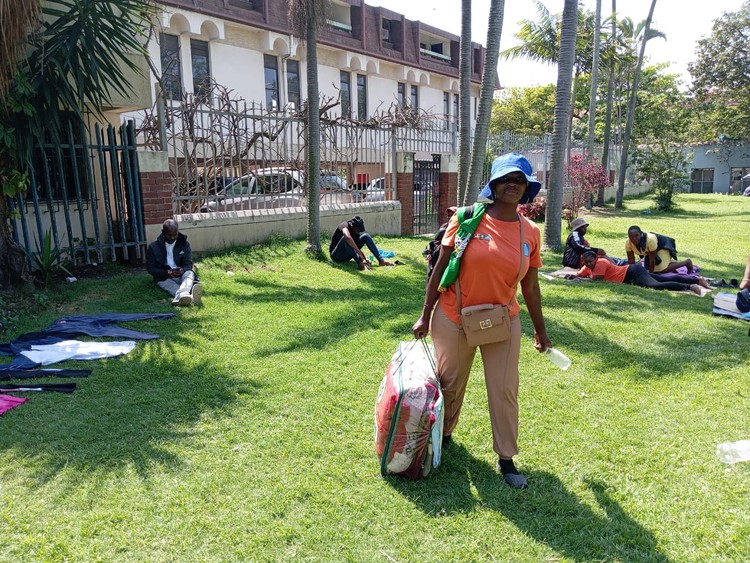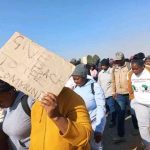A terrifying vision of South Africa’s future
Niall Reddy | Amandla 77 | August/September 2021
This is an edited version of an article which first appeared on the Africa is a Country (AIAC) website. Amandla! has an arrangement with AIAC to publish some of each other’s material.
If South Africa’s Left can’t find a way to channel popular discontentment into the building of mass progressive movements, it will instead morph into anarchy, nativism and, inevitably, authoritarianism.
Predicting a major political shockwave has been standard fare among South African pundits for some time. The sheer depth of the socio-economic crisis in the country, best captured in an unemployment rate of 42%, made it something of a safe bet.
In July, that shockwave arrived, but in a form that was perhaps less expected. Its trigger was not the increasing prices of necessities or the failing provision of basic services. Instead it was the jailing of former president Jacob Zuma, the man arguably most responsible for the parlous state of those services. Its embodiment was not mass occupations or demonstrations against an indifferent government. Instead it was the widespread looting of shops and malls, tinctured by outbursts of ethnic violence and outright criminality. It was not civil society organisations or radical opposition parties that led the unrest, but a faction of the ruling party itself.
This has made it far harder to grasp the political meaning of these events and to anticipate their consequences. Amidst a flood of analysis and reporting, interpretations of the unrest, not least within the Left, continue to diverge sharply.
Organised campaign or “bread riot”?
There is a general consensus that the unrest had these two main facets. On the one hand a seditious campaign waged by Zuma-aligned elements (henceforth Zupta) intended to sow instability. On the other, a more spontaneous attempt by desperate people with little or no connection to Zupta to secure food and basic necessities – a “bread riot”.
But that consensus breaks down over the question of how to understand the interrelation of these facets and the relative importance of each in the overall arc of events –and thus how to characterise the episode as a whole. Most commentators have tended to strongly foreground one side or the other.
A widely circulated editorial from New Frame (NF), that came out on 12th July put the emphasis firmly on the latter element. It argued that the influence of Zupta forces, beyond tossing the initial match, was marginal. Reports from NF’s journalists suggested that a substantial majority of those taking to the malls and streets had been driven there by desperation rather than any concern for Zuma. Consequently, NF saw the unrest as infused with progressive potential and drew analogies to the bread riots that preceded revolutions in the Middle East and Europe. It saw some chance that they may evolve into a more overtly political mobilisation, cohered around a clear set of demands, and even that middle class and other elements may join in on this.
Subsequent posts over the following days by NF editors sounded a somewhat different note. By this stage, there were widespread reports of deliberate acts of sabotage targeting strategic infrastructure, as well as a flood of anecdotal evidence pointing to the intervention of well-organised groupings. These appeared to show that Zupta forces were more than simply the pilot light for the unrest. Yet NF still drew a very strong distinction between its two facets. They contended the acts of sabotage were entirely “different phenomena” from the food riots and that the latter were “spontaneous … emerging from widespread desperation”.
Writing in Jacobin on 15th July, historian Ben Fogel bent the stick in the other direction. While not denying that simple desperation was a motivation for many on the streets, he firmly denied that these events could be characterised as “bread riots.” Instead he saw them as a part of a deliberate political campaign with clear objectives. In contrast to NF, he emphasised the ethnic and xenophobic dimensions of the unrest. While the title of NF’s editorial announced somewhat loftily that the riots had “turned the wheel of history,” Fogel’s exuded pessimism, declaring there to be “no silver lining” to what had transpired.
These diverging interpretations seem to arise partly from a dispute over facts, specifically about what caused the unrest. NF sees it as having been a spontaneous outburst with distinct organised currents, Fogel sees it as having been orchestrated. Clearly, it was neither one nor the other. It could not possibly have been purely spontaneous because we know at the very least that there were active instigators. At the same time we know it had spontaneous elements – it drew in a great mass of people who were acting at their own behest and for their own objectives. The real question then is about the degrees of orchestration and spontaneity.
Evidence of organisation
We are not yet in a position to know precisely what those were. But as more information is becoming available, it does seem to be pointing to a higher degree of orchestration than appeared to be the case at the start. Leaked WhatsApp messages testify to a very active role played by ANC counsellors and other local leaders. They suggest that shopping malls were deliberately targeted because they constituted symbols of “white monopoly capital”. Anecdotal evidence points to the widespread busing in of looters and the involvement of well-resourced gangs in t busing out stolen goods. This also encompassed various harder to reach (and typically well-secured) targets –warehouses, factories and shipping containers –some of which appear to have come under coordinated attack.
The geography of the uprising also suggests the importance of organised elements. If the unrest had been driven by people acting autonomously, based on a “demonstration effect”, we would have expected it to be quite diffused. Instead it seems to have remained concentrated in areas where Zupta elements have influence.
It now appears that many of the reports of attacks on water and communication facilities were false. But a number of other incidents, like the burning of a chemical plant, attacks on transport and food infrastructure and the theft from ammunition depots, still indicate orchestrated subversion unfolding under the cover of the chaos.
Political instigation crucial
Given all this, NF’s insistence that the two facets of the unrest should be seen as “distinct phenomena” is an odd one. The intent, I think, is to ringfence the actions of the mass of rioters from those of the instigators. This is done to preserve the rioters’ agency and progressive potentiality from the sordidness that started to overtake events as they progressed. Normatively that may be a valid move. But emphasising distinction too strongly as we try to come to grips with the political meaning of these events is, in my view, a mistake for several reasons.
Firstly, it again imputes a degree of autonomy and spontaneity to the riots for which there simply isn’t justification. This isn’t solely a concern for historians or academics. Understanding the precise role of active legitimation and orchestration in driving people onto the streets may be important for many of the bigger conclusions we will draw from these events. It will have a large bearing, for example, on what we think the riots tell us about the political mood of working class people in the country more broadly, and of the likelihood of similar occurrences.
Secondly, the fact that the riots took place under the aegis of the “Free Zuma” campaign is not irrelevant to understanding the political impacts they will have, or the interpretive frames that will be applied to them by other social actors. I argue below that the overweening influence of the ANC on both sides of the contestation inhibited the capacity of the riots to organically develop their own political direction, as NF hoped.
Threat to democracy
And thirdly, this emphasis has facilitated an excessive focus on one side of the issue at the expense of the other. With notable exceptions, Left commentary has leaned heavily towards framing the unrest as a symptom of socio-economic crisis while downplaying or ignoring its political causes. This might have been justified had the social dimension been otherwise overlooked or deliberately obscured. But in fact there is a striking degree of consensus in the public sphere about the importance of unemployment and inequality in explaining what happened.
The unwillingness to give proper attention to the political forces behind mid-July’s events appears symptomatic of a widespread failure on the Left to take seriously the growing imperilment of our democracy. All too frequently RET/Zupta are seen as just another faction of the elite, embroiled in a fight with other elites which does not concern us. But as last week made all too clear, those forces are in fact a serious threat to the constitutional order, and the Left should spare nothing in opposing them. Acknowledging that what happened was not just a bread riot but also a serious assault on democracy seems important in that regard.
Why no Tunisia Moment?
New Frame’s hope that the riots might gestate into a pro-poor political movement was, to be frank, wishful thinking from the start. But it’s worth inquiring as to why that was. Why did unrest on this scale, leavened by such profound desperation, show so little prospect of developing a radical edge? Why was a “Tunisia moment” simply never on the cards?
An important part of the answer, I believe, is that there has not yet been any serious breakdown in the legitimacy of the political order in South Africa. Those who see a “Tunisia moment” around every corner base their predictions on the depth of the social crisis in the country. But they tend to overlook the fact that the political crisis, while incipient, simply has not matured to the same extent. The ANC’s hegemony remains broadly intact, both at the polls and on the ground – in communities and workplaces. Hence social disaffection as it emerges has tended to channel into intra-ANC conflicts rather than arraying against the political class as a whole. A mass event of the kind we just witnessed has the potential to precipitate a bigger legitimation crisis, but it’s unlikely to bring it about on its own.
How exactly the ANC has retained its hegemony while presiding over a social crisis of this scale would be the subject of other articles. But one thing that should form part of the answer may be material for understanding recent events. A key ingredient of the ANC’s success has been its ability to continue to pose as a liberation movement even while exercising more or less uninhibited control over the state. It has achieved this in part by clinging fastidiously to the language and symbolism of its more heroic past. It conceives of itself as the protagonist of a “national democratic revolution” being waged against external forces, usually unnamed.
But much more than ideology is at work here. The ANC poses as a social movement so successfully because it in fact operates as one at a ground level. Indeed, it continues to monopolise the space in South African civil society. Its branches penetrate into virtually every working class community in the country. Total membership grew threefold between 2002 and 2012, to 1.2 million, and has since crept even higher. That membership overlaps significantly with other mass-based civil society organisations like the South African National Civics Organisation (Sanco) and the Congress of South African Trade Unions (Cosatu). Hence, local structures of the ANC become inevitable poles of attraction for nascent political leaders at a community level. This means that when popular disgruntlement bubbles over into protest and mobilisation, it is almost always the ANC on both sides of the fight – a dynamic we’ve seen time and again in service delivery protests.
This furnishes the ANC with powerful tools of co-optation and mollification while limiting the ability of these moments of protest to contribute to class formation. Protests tend to be framed as struggles against venal or corrupt elements of “the movement” rather than against distinct class interests. Where they succeed, their leaders are frequently integrated into the state or absorbed up the party hierarchy. The organisations built in the course of the mobilisation wither away. A “rebellion of the poor” thus rages on, with hardly any accretion of class ideology or organising capacity.
I don’t mention all this here to suggest that the unrest should be likened to simply another service delivery protest. But I do believe it exhibited a familiar dynamic, in which the ANC’s dominating presence on both sides of the barricades muddied the ideological waters and limited the space for an autonomous politics to develop.
All of this means that we should be more circumspect than NF’s editors in assuming that the riots presage the re-entry of the masses onto the stage of history. The impulse to defend the agency of the poor, in the face of a public discourse in which it is so frequently erased, is a valid one. But it shouldn’t lead us to a fetishisation of that agency, or to the belief that every instance of collective action by poor people heralds a new awakening.
The ANC’s supple hegemony has narrowed the space for instances of protest to cohere into larger movements. That hegemony is eroding and will do so more rapidly as the crisis persists and patronage flows constrict. But if anything better is to emerge in its stead, the Left will have to fill that space by building up its own organisations and political vehicles – not from above or without, but rooted in the organic militants that have sustained a culture of resistance over the post-Apartheid period.
Niall Reddy is a political economist and organiser.
The post A terrifying vision of South Africa’s future appeared first on Amandla.






